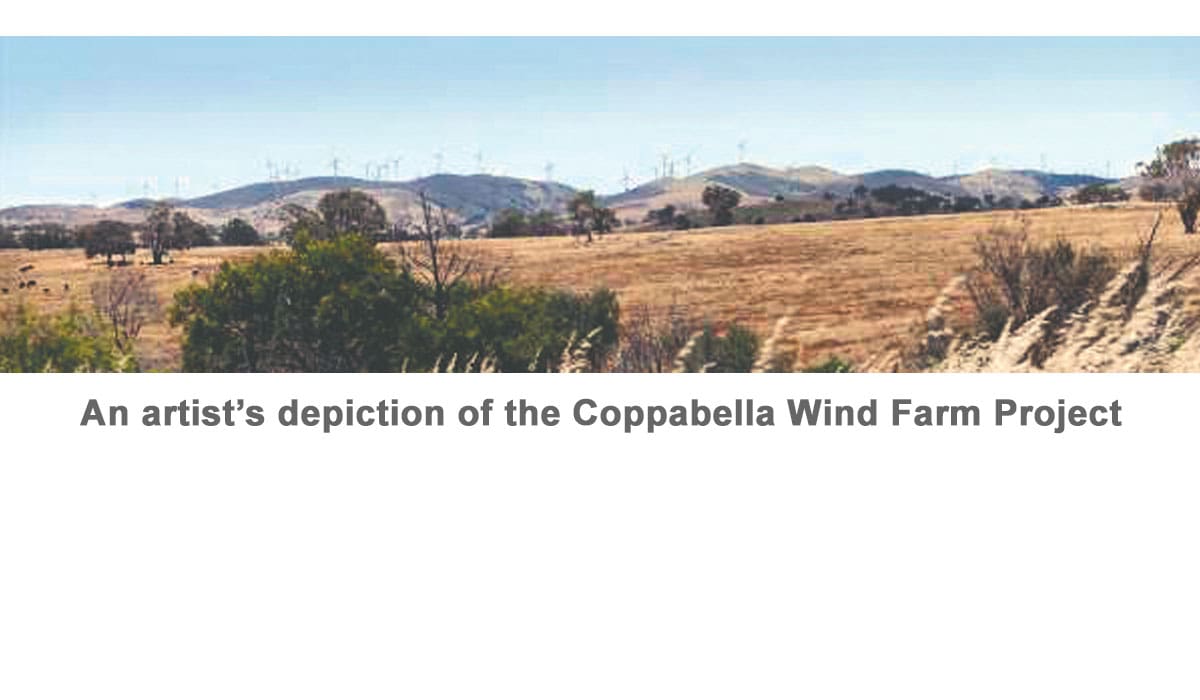Wind, Solar and renewable energy company Epuron has welcomed the recommendation for approval of the Yass Valley Wind Farm by the NSW Department of Planning and Environment, with the NSW Planning and Assessment Commission (PAC) now in a position to make its final determination.
According to Epuron, they are one of Australia’s most successful wind farm developers. They have developed the highest yielding wind farm, largest wind farm, the largest number of wind farms, and the largest number of wind turbines in NSW.
The NSW Department of Planning and Environment recommendation represents a significant reduction in scale of the project, from 124 turbines down to 79. A spokesman said “We are yet to review the basis of this reduction which is difficult to accept given the community support the project has received. Despite the recommendation to limit approval of the project to the Coppabella Precinct alone, we are pleased that the Yass Valley Wind Farm will contribute to reducing greenhouse gas emissions from electricity generation in NSW”.
However, there is considerable opposition to the Epuron development. Mark Glover, an opponent of the wind turbines, compiled a submission to the Select Committee on Wind Turbines in May 2013 discussing their impact on aerial agricultural operations. It argued that wind turbines cause an area of turbulence up to 20 kilometres downwind, and cited the Aerial Agriculture Association of Australia’s recommendation that its members don’t fly in areas with wind turbines due to this turbulence. The submission also argued that a pilot taking off from the airstrip at ‘Talbragar’, in the Harden Shire, would be unable to gain sufficient altitude before encountering the turbines.
The New South Wales Department of Planning and Environment also found in February of 2015 that aircraft taking off from nine airstrips in the area would encounter the same problem in being unable to gain sufficient altitude.
This has caused the project to previously stall. Construction Manager, Andrew Wilson said that the project had been on hold for a number of months, and meetings of the Yass Valley Wind Turbine Community Consultative Committee did not occur until further developments in the project occured The Yass Valley Wind Farm, to be located 17km west of Yass, has been under development since 2009.
According to Epuron, when first conceived, the project included more than 150 wind turbines. Through a number of refinements based on feedback from the community, expert consultants and government stakeholders, the size of the project had been reduced to its final proposal for 124 wind turbines. Each turbine can bring up to $10,000 to the land owner with some land owners already in negotiations to have up to three on their property.
The NSW Department of Planning is responsible for assessment of the project and for making a recommendation to the Planning Assessment Commission (PAC), the consent authority for this project. In February 2015 the Department recommended refusal of the project. Epuron then presented PAC with its response to the Departments recommendation. In April 2015 the PAC subsequently returned the application to the Department requesting it to review its report and recommendations. The Department has now completed that process and provided a revised recommendation to PAC for its determination.
This news may not come as good news to opponents of wind turbines, who point to their lack of aesthetic appeal in an otherwise idyllic country landscape. But their most significant, and controversial, argument is that wind turbines cause negative health effects akin to seasickness.
According to Associate Professor Simon Carlisle of the University of Sydney, low frequency sound, known as infrasound, has an effect on the human body. “It’s stimulating the system that’s involved in balance – the vestibular system. So there’s some good physiology, some good neuroscience, that this does exist and it’s been shown in animal models,” he told The Australian in June 2015. Although a small percentage of people may be susceptible to these low frequency sounds, they can experience feelings of nausea and sleep disturbance.
However, the National Health and Medical Research Council has concluded that there “there is currently no consistent evidence that wind farms cause adverse health effects in humans.”
Martin Poole, Executive Director of Epuron said: “It’s time to deliver on the NSW Renewable Energy Action Plan. We are keen to contribute to NSW capturing the important jobs and investment from large scale renewable energy projects which have mainly been secured by other states. It is important that NSW demonstrates its commitment to maximising the local jobs and expertise that flow from the transition to a cleaner electricity sector. Epuron looks forward to a positive determination by the PAC early in 2016.”
Epuron have stated the turbines generate 975 gigawatt hours (GWh) of clean electricity per annum, enough power for 133,500 homes. Save 1 million tonnes of greenhouse gas emissions each year and 3.3 million tonnes by 2020; bring jobs and opportunity into the region from a $620 million investment; and provide local community benefits via a community fund of $2,500 per wind turbine, or more than $300,000 per annum if all turbines are built.
For more information contact: Andrew Durran, Martin Poole 0407 206 199 or 0411 159 114. For more information, visit www.epuron.com.au.

